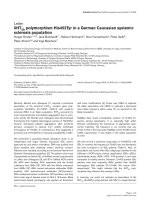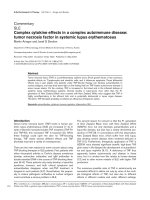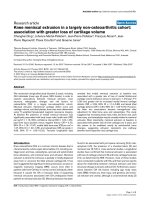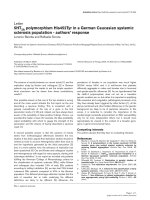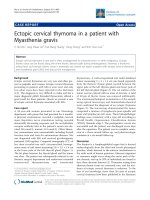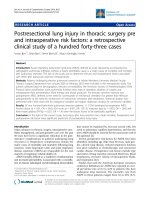Báo cáo y học: "“Floating arm” injury in a child with fractures of the proximal and distal parts of the humerus: a case report" docx
Bạn đang xem bản rút gọn của tài liệu. Xem và tải ngay bản đầy đủ của tài liệu tại đây (464.54 KB, 4 trang )
Case report
Open Access
“Floating arm” injury in a child with fractures of the proximal and
distal parts of the humerus: a case report
Melih Güven
1
*, Budak Akman
2
, Tanzer Kormaz
3
,Og
˘
uz Poyanlı
2
and
Faik Altıntas¸
4
Addresses:
1
Department of Orthopaedics and Traumatology, The Hospital of University of Abant Izzet Baysal, Bolu, Turkey
2
Department of Orthopaedics and Traumatology, Göztepe Training and Research Hospital, Istanbul, Turkey
3
Department of Emergency Medicine, The Hospital of University of Abant Izzet Baysal, Bolu, Turkey
4
Department of Orthopaedics and Traumatology, Yeditepe University, School of Medicine, Istanbul, Turkey
Email: MG* - ; BA - ; TK - ; OP - ;
FA -
* Corresponding author
Received: 14 January 2009 Accepted: 9 June 2009 Published: 17 September 2009
Journal of Medical Case Reports 2009, 3:9287 doi: 10.4076/1752-1947-3-9287
This article is available from: />© 2009 Güven et al.; licensee Cases Network Ltd.
This is an Open Access article distributed under the terms of the Creative Commons Attribution License (
/>which permits unrestricted use, distribution, and reproduction in any medium, provided the original work is properly cited.
Abstract
Introduction: Simultaneous supracondylar humerus fracture and ipsilateral fracture of the proximal
humerus in children is rare.
Case presentation: A 10-year-old Turkish boy with an extension type supracondylar humerus
fracture and ipsilateral fracture at the proximal metaphyseal-diaphyseal junction of the humerus was
treated by closed reduction and percutaneous Kirschner wire fixation. Closed reduction was
performed using a Kirschner wire as a “joystick” to manipulate the humeral shaft after some swelling
occurred around the elbow and shoulder.
Conclusion: The combination of fractures at the proximal and distal parts of the humerus can be
termed as “floating arm” injury. Initial treatment of this unusual injury should be focused on the
supracondylar humerus fracture. However, closed reduction can be difficult to perform with the
swelling around the elbow and shoulder. A temporary Kirschner wire can be used as a “joystick” to
fix and reduce the fracture.
Introduction
Supr acondylar humerus fractures are usually isolated
injuries in children, but sometimes they can be associated
with ipsilateral fractures of the forearm. The combination
of such injuries is known as “floating elbow” [1-4].
However the combination of supracondylar humerus
fracture with an ipsilateral fracture of the proximal
humerus is extremely rare. To the best of our knowledge,
only two cases have been reported in the literature
previously [5,6]. It was pointed out in these reports that
swelling around the elbow and shoulder regions could
make closed reduction difficult. We describe the case of a
10-year-old boy who had an extension type supracondylar
humerus fracture and ipsilateral fracture at the proximal
Page 1 of 4
(page number not for citation purposes)
metaphyseal-diaphyseal junction of the humerus. Both
fractures were treated successfully by closed reduction and
percutaneous Kirschner wire fixation.
Case presentation
A 10-year-old Turkish boy who had fallen from a height of
approximately 2 meters onto his outstretched left hand
was referred to our hospital one hour after the injury. He
complained of pain in the left elbow and shoulder. The
proximal part of the left arm and elbow had swelling and
crepitus. His neurovascular examination was normal.
Plain radiographs showed a displaced fracture at the
proximal metaph yseal-di aphyseal junction of the left
humerus and ipsilateral displaced extension type supra-
condylar humerus fracture (Figure 1). His left upper
extremity was splinted and the patient was taken to the
operating room on the same day.
Under general anesthesia, closed reduction of the supra-
condylar humerus fracture was initially attempted under
fluoroscopic control. However, it could not be achieved
with manipulation because it was difficult to perform
closed reduction on the severely swollen upper limb.
A 3 mm temporary Kirschner wire was inserted to the
humeral shaft from the lateral to medial direction. With
the assistance of this “joystick” Kirschner wire, the humeral
shaft was manipulated easily and closed reduction and
percutaneous fixation with three Kirschner wires were
performed. Once the supracondylar humerus fracture was
stabilized, the management of the proximal humerus
fracture was relatively straightforward. Closed reduction
with gentle manipulation and percutaneous fixation with
two Kirschner wires were applied to the proximal humerus
fracture (Figure 2). After the operation, we used a plaster of
Paris splint to immobilize the left upper extremity.
We removed the Kirschner wires from both the elbow and
the shoulder and the splint as an outpatient procedure
after 4 weeks of radiographic healing and a range of
motion exercises were begun. During the final follow-up
6 months after the surgery, plain radiographs showed
adequate healing without any angular deformity on the
elbow and shoulder (Figure 3). The patient gained full
function of shoulder motion, with elbow extension and/or
flexion of 0° to 130°, pronation and/or supination of 80°
each and equal to the uninjured side.
Discussion
Stanitski and Micheli [1] first used the descriptive term
“floating elbow” to describe the combination of ipsilateral
fracture of the elbow and forearm. Gausepohl et al. [7]
reported a case with fracture dislocation of the elbow
combined with unstable distal forearm fracture of the
ipsilateral upper extremity and termed this injury as
“floating forearm”. Similarly, we prefer the term “floating
arm” to describe this rare combination of the fractures at
the elbow and shoulder regions.
We have found only two cases in the English language
literature in which the combination of ipsilateral proximal
humerus fracture, flexion type supracondylar humerus
fracture and olecranon fracture were present [5,6]. The
authors of both reports recommended that the supracon-
dylar humerus fracture should be reduced first and
percutaneously fixed before the reduction of proximal
Figure 1. Preoperative (A) anteroposterior roentgenogram
of the left upper extremity and (B) lateral roentgenogram of
the left elbow.
Figure 2. Early postoperative roentgenograms of (A) left
shoulder and (B, C) left elbow.
Page 2 of 4
(page number not for citation purposes)
Journal of Medical Case Reports 2009, 3:9287 />humerus fracture. However, they could not achieve closed
reduction for the supracondylar humerus fracture due to
the combination of fractures in the same extremity and
resulting instability. Therefore, they performed open
reduction.
Extension types of supracondylar humerus fractures are
mostly accepted as pure hyperextension injuries that are
caused by a fall onto the outstretched hand with
hyperextension of the elbow [8]. Proxima l humerus
fractures in children can occur as a result of a direct blow
to the shoulder area or indirectly as a fall onto an
outstretched hand. This causes a forced position of the
upper extremity resulting in a fracture of the proximal
humerus [9]. The “ floating arm” injury presents a more
serious injury than an isolated supracondylar fracture or
an isolated fracture of the proximal humerus and reflects a
more violent episode of trauma. Due to swelling around
the elbow and shoulder, closed reduction, especially for
the supracondylar humerus fracture, is not always
possible. Parmaksizoglu et al. [10] described an alternative
closed reduction method to avoid open reduction for
supracondylar humerus fractures in children. They con-
cluded that a temporary Kirschner wire d riven as a
“joystick” to the humeral shaft before percutaneous
fixation made reduction and fixation of the supracondylar
humerus fracture easier by controlling the proximal
fragment. This technical trick also facilitates closed
reduction of the supracondylar humerus fracture in a
“floating arm” injury like in our case. A temporary
Kirschner wire allows the surgeon to stabilize the humeral
shaft and control the motion in the coronal, sagittal and
horizontal planes for both supracondylar and proximal
humeral fractures.
Conclusion
The supracondylar humerus fracture should be reduced
initially in a “floating arm” injury. However, closed
reduction can be difficult to perform due to severe
swelling around the elbow and shoulder regions asso-
ciated with this injury. Insuchcases,atemporary
Kirschner wire can be used as a “joystick”.
Competing interests
The authors declare that they have no competing interests.
Consent
Written informed consent was obtained from the patient’s
parents for pu blication of this case report an d any
accompanying images. A copy of the written consent is
available for review by the Editor-in-Chief of this journal.
Authors’ contributions
MG and BA contributed to the conception and design, and
carried out the literature research, manuscript preparation
and manuscript review. TK and OP were involved in the
literature review and helped draft part of the manuscript.
FA contributed to the conception and design. MG, TK and
OP revised the manuscript.
Acknowledgements
No funding has been received for the study.
References
1. Stanitski CL, Micheli LJ: Simultaneous ipsilateral fractures of
the arm and forearm in children. Clin Orthop Relat Res 1980,
153:218-222.
2. Roposch A, Reis M, Molina M, Davids J, Stanley E, Wilkins K,
Chambers HG: S up raco ndy lar fract ure s of th e humerus
associated with ipsilateral forearm fractures in children: a
report of forty-seven cases. J Pediatr Orthop 2001, 21:307-312.
3. Biyani A, Gupta SP, Sharma JC: Ipsilateral supracondylar fracture of
humerus and forearm bones in children. Injury 1989, 20:203-207.
4. Harrington P, Sharif I, Fogarty EE, Dowling FE, Moore DP: Manage-
ment of the floating elbow injury in children. Simultaneous
ipsilateral fractures of the elbow and forearm. Arch Orthop
Trauma Surg 2000, 120:205-208.
5. Gül A, Sambandam S: Ipsilateral proximal and flexion supra-
condylar humerus fracture with an associated olecranon
fracture in a 4-year-old child: a case report. Eur J Orthop Surg
Traumatol 2006, 16:237-239.
6. James P, Heinrich SD: Ipsilateral proximal metaphyseal and
flexion supracondylar humerus fractures with an associated
olecranon avulsion fracture. Orthopedics 1991, 14:713-716.
7. Gausepohl T, Mader K, Kirschner S, Pennig D: The “floating
forearm” injury in a child: a case report. Strat Traum Limb Recon
2007, 2:48-54.
Figure 3. Postoperative roentgenograms of (A) left upper
extremity and (B, C) left elbow at six months.
Page 3 of 4
(page number not for citation purposes)
Journal of Medical Case Reports 2009, 3:9287 />8. Kasser JR, Beaty JH: Supracondylar fractures of the distal
humerus.InRockwood and Wilkins’ Fractures in Children. Edited by
Beaty JH, Kasser JR. 5
th
edition. Volume 1. Philadelphia: Lippincott
Williams and Wilkins; 2001:617-621.
9. Kwon Y, Sarwark JF: Proximal humerus, scapula and clavicle.In
Rockwood and Wilkins’ Fractures in Children. Edited by Beaty JH,
Kasser JR. 5
th
edition. Volume 1. Philadelphia: Lippincott Williams and
Wilkins; 2001:741-751.
10. Parmaksizoglu AS, Ozkaya U, Bilgili F, Sayın E, Kabukcuoglu Y: Closed
reduction of the pediatric supracondylar humerus fractures:
the “joystick” method. Arch Orthop Trauma Surg 2008, doi:
10.1007/s00402-008-0790-8. [Epub ahead of print].
Do you have a case to share?
Submit your case report today
• Rapid peer review
• Fast publication
• PubMed indexing
• Inclusion in Cases Database
Any patient, any case, can teach us
something
www.casesnetwork.com
Page 4 of 4
(page number not for citation purposes)
Journal of Medical Case Reports 2009, 3:9287 />
